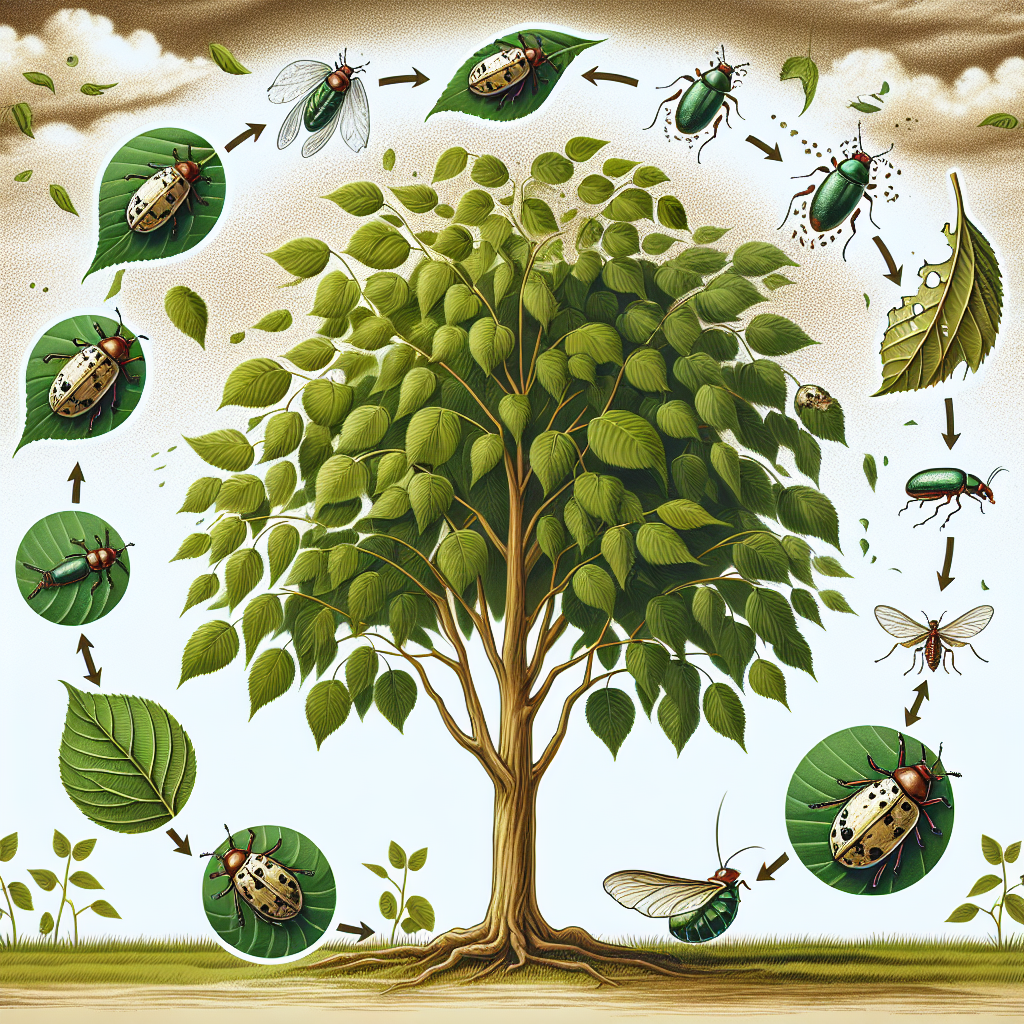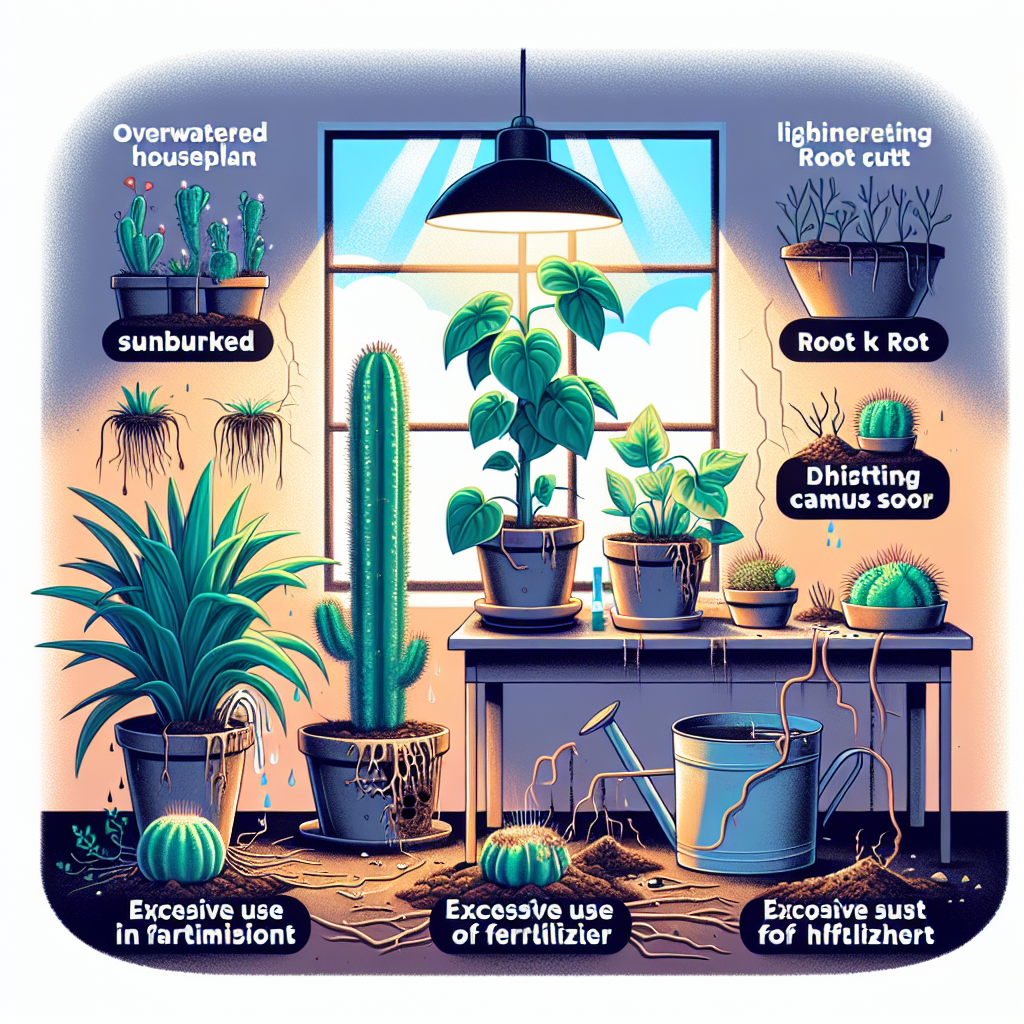How to Stop Leaf Beetles on Elm Trees
Updated June 27, 2024 at 8:17 am
Combat the relentless assault of leaf beetles on your beloved elm trees with our practical guide, chock-full of effective strategies and expert tips to protect your leafy giants from these voracious pests.

Understanding Leaf Beetles and Elm Tree Health
Dealing with pesky leaf beetles on your beloved elm trees can be frustrating, but understanding the nature of these critters can be the first step towards managing them. Elm leaf beetles, also known as Xanthogaleruca luteola, are small insects that can cause significant damage to the foliage of elm trees.
Recognizing Leaf Beetle Damage: The first tell-tale signs of an infestation are the skeletonized leaves and the yellowish to brownish discoloration of the foliage. If left unchecked, these insects can cause leaves to drop prematurely, which can eventually weaken your trees and make them more susceptible to disease and other pests.
Integrated Pest Management Strategies
When it comes to controlling leaf beetles, opting for an integrated pest management (IPM) approach can be effective. IPM involves using a combination of cultural, physical, biological, and chemical control methods to manage pest populations in an environmentally sensitive manner.
Regular Monitoring: Keeping an eye on your elm trees, especially from late spring through summer, is crucial. Regular inspections can help you catch an infestation early on, making it easier to manage.
Non-Chemical Interventions
Mechanical and cultural control methods are a good starting point for managing leaf beetles. These non-chemical options are safer for the environment and beneficial insects that may be present in your garden.
Physical Removal: If you notice beetles or larvae on your trees, consider physically removing them by hand or with a strong jet of water. Though labor-intensive, this can significantly reduce the population.
Utilizing Biological Controls
Biological control is another integral part of an IPM strategy. This involves using natural predators or parasites to keep the leaf beetle population in check.
Natural Predators: Encouraging or introducing beneficial insects, such as ladybugs and green lacewings, can help as they are natural predators of leaf beetle larvae. Planting a diverse garden that includes flowering plants can attract these allies to your elm trees.
Chemical Control as a Last Resort
While chemical interventions should be used judiciously, they might be necessary when dealing with severe infestations. Always opt for the least toxic options and follow label instructions carefully.
Selective Insecticides: Products containing neem oil, pyrethrin, or insecticidal soaps can be less harmful to beneficial insects and are known to control leaf beetle populations effectively when applied at the right time.
Recommended Insecticides for Leaf Beetle Control
When non-chemical methods are not enough, the market offers several effective insecticides for managing leaf beetle infestations. Always ensure you’re using products registered for use on elm trees and abide by the application guidelines.
For instance, Bonide’s Neem Oil is a popular choice among gardeners dealing with various pests, including leaf beetles. It’s derived from the neem tree and acts as an insecticide, fungicide, and miticide. Many gardeners appreciate its organic nature and broad-spectrum use, making it a versatile option for pest management.
Find This and More on Amazon
Spinosad: Another product acclaimed for its effectiveness and lower impact on non-target species is Monterey Garden Insect Spray containing Spinosad. It’s regarded highly for its ability to control beetles while still being acceptable for use in organic farming.
Cultural Practices to Prevent Leaf Beetle Infestations
Adopting sound cultural practices can greatly reduce the risk of leaf beetle invasions. A healthy tree is less likely to succumb to pest infestations and diseases.
Proper Watering and Fertilization: Maintaining a proper watering schedule and providing balanced fertilization can promote vigorous growth and the natural resistance of elm trees to pests.
Creating a Beetle-Resistant Environment
In addition to targeted interventions, altering the local environment can make it less hospitable to leaf beetles, disrupting their life cycle.
Sanitation: Regularly cleaning up fallen leaves and debris around your elm trees removes potential breeding grounds and overwintering sites for the beetles.
Towards a Beetle-Free Garden
While it may seem like a daunting task, being consistent with monitoring and employing a strategic combination of control methods can greatly enhance your chances of successfully protecting your elm trees from leaf beetles.
Remember that patience and persistence are key. It may take some time to see significant improvements, but with diligent care, you can create a thriving, beetle-free environment for your elm trees.
Exploring Mechanical Control Options
If you’re hesitant about using chemicals, exploring mechanical means to control leaf beetles can be a suitable alternative. This could include barriers or traps specifically designed to capture or repel beetles.
Sticky Traps: Setting up sticky traps around the trees can catch adult beetles, thereby reducing the population and potential for damage.
When to Call the Professionals
Sometimes, despite your best efforts, leaf beetle infestations can get out of hand. In such cases, it might be prudent to call in professional arborists or pest management services.
Professional services can offer more potent solutions and customized treatment plans, ensuring your elm trees receive the care they need to overcome an infestation.
Comprehensive Care for Elm Trees
Protecting your elm trees from leaf beetles involves a holistic approach that encompasses regular maintenance, timely interventions, and fostering a conducive environment for tree health.
By combining all available strategies, you’ll be better equipped to stop leaf beetles on elm trees and enjoy the beauty these majestic plants bring to your landscape.
Additional Resources for Elm Tree Care
For more detailed guidance on maintaining healthy trees and preventing pest issues, explore other resources such as tips on harvesting and caring for your entire garden. Understanding the ecosystem of your backyard can lead to healthier plants, both edible and ornamental.
Moreover, the knowledge on nurturing Zamioculcas plants in low-light environments can also provide insights into the care of shade-loving outdoor plants, showing how an understanding of one plant’s needs can benefit another’s.
In conclusion, successfully managing leaf beetles on elm trees requires a multifaceted approach involving monitoring, preventive measures, and appropriate interventions when needed. From non-chemical practices to the judicious use of insecticides, each step plays a critical role in maintaining the health of your elm trees. Surrounding yourself with a wealth of knowledge, from indoor plant care strategies to the intricacies of outdoor gardening, can strengthen your overall approach to plant health and pest management. With persistence and informed actions, you can protect your elm trees and ensure they continue to thrive for years to come.
Understanding Elm Tree Varieties and Vulnerability
Elm trees, with their distinctive vase-shaped profile, offer more than just aesthetic appeal – they’re an integral part of our urban and rural landscapes. However, different species of elms possess varying levels of resistance to pests like the leaf beetle.
Elms such as the American and English varieties might be a common sight in many areas, but their susceptibility to pests can vary. It’s essential to identify your elm species, as this information can guide your approach to pest management and overall tree care.
Preventative Measures to Deter Elm Leaf Beetles
Prevention is always better than cure, particularly in garden pest management. Cultivating a beetle-resistant garden goes beyond just chemical treatments – it often involves a change in gardening practices that can enhance the physical health of your elm trees.
Mulching and Ground Cover: A well-mulched area around elm trees can prevent weeds, maintain soil moisture, and reduce the chance of beetle infestation. Ground covers can also serve as a habitat for beneficial insects that prey on the beetles.
Understanding the Life Cycle of Leaf Beetles for Effective Control
The life cycle of leaf beetles includes eggs, larvae, pupae, and adults, with each stage presenting an opportunity for intervention. Understanding the timing of these stages in your local climate is critical, as it informs the best time for specific control measures.
Monitoring Life Stages: By knowing when the beetles lay eggs and when larvae are actively feeding, you can time your control strategies to be the most effective, such as applying insecticides or releasing biological agents.
Elm Tree Maintenance to Support Pest Resilience
A well-maintained elm tree is more capable of withstanding beetle attacks and recovering from the damage quickly. Routine maintenance tasks, such as pruning and soil care, are not just about tree aesthetics but also about promoting its health and resistance to pests.
Pruning: Regular pruning helps to remove beetle-infested branches and also allows for better air circulation and sunlight penetration, which can deter pests and promote stronger, healthier growth.
Climate Considerations and Leaf Beetle Activity
Leaf beetles activity can be heavily influenced by local climate conditions. Regions with warmer winters may experience more intense or prolonged beetle activity throughout the year. Addressing these regional differences is essential for an effective pest control plan.
For instance, gardeners living in cooler climates might have a shorter period during the year when beetle activity is a concern, allowing for more targeted and infrequent interventions.
Attracting Elm Tree Allies: Beneficial Fauna
To tip the scales in favor of your elm trees, consider creating an environment that supports fauna which are natural enemies to the leaf beetle. A robust ecosystem in your garden can do some of the heavy lifting in pest control.
For example, birds play a significant role in controlling beetle populations. Setting up bird feeders and baths can attract our feathered friends, who will also feast on the beetles and larvae on your elms, minimizing the need for further interventions.
Understanding Neem Oil’s Place in Pest Management
Neem oil, extracted from the seeds of the neem tree, Azadirachta indica, has been lauded for its pesticidal properties. It not only repels beetles but also inhibits their feeding and disrupts their life cycle.
Functionality: Neem oil is particularly valuable as it works on multiple fronts. It also offers a safe profile, with minimal risks to pets, people, and the beneficial insects that are paramount to a balanced garden ecosystem.
Exploring Spinosad’s Advantages for Elm Beetle Control
Derived from the naturally occurring bacterium, Saccharopolyspora spinosa, Spinosad has gained attention for its effective control of a wide range of insect pests, including the elm leaf beetle.
User Experience: Gardeners who turn to Monterey Garden Insect Spray, which contains Spinosad, are often seeking a solution that is tough on pests but gentle on the environment. Its organic certification is an added benefit for those looking to maintain an organic garden.
Find This and More on Amazon
Reflecting on Past Successes and Failures in Beetle Management
Every garden is unique, and an intervention that works in one might not work in another. It’s vital to keep a record of what has and hasn’t worked in controlling leaf beetles in your specific context.
Learning from past experiences and adjusting your strategies accordingly can save time, resources, and help you develop a more targeted approach to managing leaf beetles on your elm trees.
How Soil Health Affects Elm Tree Defenses
Healthy soil underpins the overall health of any garden or landscape, including the elm trees within it. Soil teeming with beneficial microbes supports robust root systems and can equip trees with enhanced defenses against pests like the elm leaf beetle.
Conducting regular soil tests can provide valuable insights into nutrient levels and the presence of healthy microorganisms, guiding your fertilization and amendment plans to bolster your trees’ health from the ground up.
The Role of Community in Addressing Pest Problems
Protecting elm trees from leaf beetles isn’t just an individual effort – it can benefit from community involvement. For instance, neighboring gardens with beetle issues can impact your control efforts.
By sharing knowledge, resources, and strategies with your neighbors, you can adopt a more coordinated approach to managing leaf beetle populations in your local area, thereby enhancing the effectiveness of your individual efforts.
Seasonal Planning for Elm Beetle Prevention
Different seasons require different approaches to manage leaf beetles. What’s effective in the spring might not be as appropriate in the fall. Creating a seasonal plan that aligns with the life cycle of the beetles can dramatically improve control measures.
Adjust your maintenance and inspection routines with the changing seasons to stay ahead of beetle activity and prevent infestations from becoming unmanageable.
Assessing Tree Health: When to Take Action
Being proactive in assessing the health of your elm trees can catch infestations before they become severe. Regular tree health check-ups, much like our own health check-ups, can detect problems early and guide timely intervention.
Look for changes in leaf color, texture, and overall tree vigor. These could signal a growing beetle issue, prompting you to step up your control efforts before extensive damage occurs.
The Right Timing for Using Chemical Controls
While we’ve touched on the use of chemical controls sparingly, timing is everything. For instance, applying certain insecticides at the wrong time might miss the window of maximum effectiveness against beetle larvae or adults.
Application Recommendations: Always coordinate insecticide applications with beetle life cycles, aiming for periods when they’re most vulnerable, such as during peak larval stages or when adult beetles first appear.
Accessing Professional Help: Arborist and Pest Expert Insights
When pest issues seem intractable, or when you’re unsure of the best course of action, consulting a certified arborist or pest expert can provide tailored advice for your specific situation.
Arborists can offer a comprehensive health assessment of your elm trees and present advanced management options that may be more effective or less known among the general gardening population.
Utilizing Technology for Pest Management
In the digital age, a variety of mobile apps and online resources are available to assist in managing garden pests. These tools can offer identification help, treatment suggestions, and even localized pest alerts.
Taking advantage of these technological aids can provide additional support in your fight against elm leaf beetles, complementing your hands-on efforts with data-driven insights.
Nurturing a Healthy Garden Ecosystem to Ward Off Pests
Finally, it’s essential to recognize that a healthy garden ecosystem – replete with a mix of plant species, beneficial insects, birds, and fauna – forms a natural bulwark against pest issues like leaf beetles on elm trees.
In this way, a garden is much like a community, where every member has a role to play in maintaining balance. Cultivating such an ecosystem takes patience and dedication but can yield a rich and vibrant garden less troubled by pests.
Summary: Protecting Your Elm Trees from Leaf Beetles
To summarize, it’s clear that an integrated and informed approach is vital in combatting leaf beetles. Whether it’s adopting certain cultural practices, leveraging chemical controls with caution, seeking professional advice, or using technology to your advantage, the key lies in a multifaceted strategy.
Carefully monitoring the health of your elm trees, nurturing a diverse garden ecosystem, and being adaptable to seasonal and climatic variations are all part of this comprehensive approach. It’s about being vigilant, proactive, and resourceful, all while keeping the well-being of your elm trees and garden in mind.
Maintaining the grandeur and health of your elm trees, along with the beauty they bring to our landscapes, is a responsibility and pleasure all gardeners share. So let’s keep the battle against leaf beetles strategic, environmentally conscious, and effective, for the sake of our cherished elms and the ecosystems they support.
Choosing the Right Soil and Amendments for Elm Tree Health
The foundation of any strong tree, including elm trees, begins with the right kind of soil. This becomes even more critical when discussing the health of the tree in the context of pest resistance, such as fighting against leaf beetles.
Soil Types and Adjustments: Elm trees thrive in well-drained soil, but they are adaptable to many soil types. However, ensuring proper drainage and aeration can prevent waterlogging, which weakens the tree and makes it more susceptible to pests. If your soil is too clayey or compacted, consider amending it with organic matter to improve its structure.
Building a Sustainable and Organic Elm Tree Care Routine
Incorporating organic practices into your elm tree care routine not only benefits the trees but the entire ecosystem surrounding them. This includes using organic mulches, compost, and avoiding synthetic chemicals as much as possible.
Organic Practices: By using compost as a soil amendment, you can improve the soil’s fertility and its capacity to retain moisture, which in turn encourages the growth of beneficial microorganisms that can aid in pest control.
Timing and Techniques for Effective Pruning
Pruning is an essential aspect of maintaining tree health, but did you know that the timing of pruning can also influence the prevalence of pests?
Best Pruning Practices: It is typically recommended to prune elm trees during the dormant season to prevent the spread of diseases and minimize stress on the tree. Removing dead or weakened branches can also eliminate potential habitats for leaf beetles.
Understanding and Managing Elm Tree Stress Factors
A stressed tree is more vulnerable to pest infestations including leaf beetles. Stress can be caused by various factors such as drought, excessive water, nutrient deficiencies, or physical damage to the tree.
Identifying Stress Indicators: Paying close attention to signs like wilting leaves, cracks in the bark, or an overall lack of vigor can help you address the underlying issues before pests like leaf beetles can exploit these weaknesses.
Enhancing Elm Tree Vigor through Proper Nutrition
Like any living organism, elm trees require proper nutrition to maintain their health and vigor, which in turn helps them resist pests like the leaf beetle. The key is in providing balanced and timely fertilization.
Fertilization Tips: Using a slow-release, balanced fertilizer can provide elm trees with the nutrients they need without causing the rapid growth that can sometimes attract pests. Over-fertilization can be just as harmful as neglect, so always follow recommended guidelines.
Leaf Beetle Control Success Stories and Case Studies
Learning from others’ experiences in managing and conquering leaf beetle infestations can be both inspiring and educational. Case studies often provide innovative solutions and strategies that you might not have considered.
Case Study Insights: Perhaps a nearby arboretum has successfully implemented a biological control program or a neighbor’s vigilant pruning schedule has made a difference. These stories can provide real-world insight to bolster your own pest management plan.
The Impact of Climate Change on Pest Dynamics
Climate change alters the behavior of pests, including leaf beetles, affecting their life cycles and potentially leading to more severe infestations. Being aware of these shifts is crucial for adapting your pest management strategies accordingly.
Adapting to Changes: Warmer temperatures might cause leaf beetles to emerge earlier, which means monitoring and interventions would also need to occur sooner. Keeping abreast of climate trends helps you stay proactive in your approach.
Collaborating with Local Extension Offices for Resources and Support
Extension offices are an excellent resource for gardeners facing pest issues like leaf beetles. These offices often provide localized advice and resources that can be invaluable in your management efforts.
Extension Services: Reach out to your local extension office for advice on best practices, workshops, or even pest alerts. They can also provide soil testing services and recommendations for your specific area.
Planning a Garden Layout that Discourages Pest Infestations
When planning your garden or landscape layout, consider how the placement of trees, plants, and other elements can impact pest management. Strategic design can prove to be an effective deterrent to pests like leaf beetles.
Garden Design: For instance, locating elm trees away from known beetle hotspots or creating buffer zones with pest-resistant plants can help minimize infestations. Companion planting and biodiversity can also play a role in naturally keeping pests at bay.
Using Companion Planting to Protect Elm Trees from Beetles
Companion planting is the strategic placement of plants for mutual benefits, which can include pest deterrence. Certain plants may help protect elm trees by either repelling beetles or attracting their predators.
Companion Choices: Consider plants like chrysanthemums and marigolds, which are known to have natural pest-repellent properties. Not only do they add color and variety to your garden but also serve as a natural line of defense against pests.
Leveraging Community Plant Swaps to Promote Resistant Varieties
Community plant swaps are more than just a fun way to diversify your garden. They can be an opportunity to share and obtain more resistant elm tree varieties or companion plants that can aid in the fight against leaf beetles.
By engaging with a network of fellow gardeners, you can learn from each other’s successes and failures, and together, fortify your community’s elm trees against common pests.
Embracing New Research on Elm Tree Health and Pest Resistance
Staying informed of the latest research on elm tree health and pest resistance is key to staying one step ahead of issues like leaf beetles. Science constantly evolves, and so should our garden practices.
Keeping Up with Studies: Whether it’s a new resistant elm variety or a breakthrough in organic pest control, keeping up with scientific findings can inform and improve your pest management tactics.
Safeguarding Your Elm Trees: A Comprehensive Approach to Pest Management
Ultimately, safeguarding your elm trees from leaf beetles takes a vigilant and comprehensive approach that considers the health of the tree, the local environment, and the broader ecosystem working together. Each measure, whether preventive or reactive, plays a part in an overarching strategy designed to enhance the vitality of your trees and the resilience of your garden as a whole.
Engaging with your community, utilizing organic methods, adopting new technologies, and staying current with research are all part of the greater effort to protect the iconic elm tree from the threat of leaf beetles. With dedication and informed practices, your elms can continue to be a source of beauty and shade for many generations.
Shop more on Amazon
Flowers & Plants Team
Flowers & Plants Team


